9
1
0
2
r
a
M
0
1
]
G
L
.
s
c
[
2
v
6
9
5
0
0
.
1
0
9
1
:
v
i
X
r
a
JOURNAL OF LATEX CLASS FILES, VOL. X, NO. X, DECEMBER 2018
1
A Comprehensive Survey on Graph Neural
Networks
Zonghan Wu, Shirui Pan, Member, IEEE, Fengwen Chen, Guodong Long,
Chengqi Zhang, Senior Member, IEEE, Philip S. Yu, Fellow, IEEE
Abstract—Deep learning has revolutionized many machine learning tasks in recent years, ranging from image classification and video
processing to speech recognition and natural language understanding. The data in these tasks are typically represented in the
Euclidean space. However, there is an increasing number of applications where data are generated from non-Euclidean domains and
are represented as graphs with complex relationships and interdependency between objects. The complexity of graph data has
imposed significant challenges on existing machine learning algorithms. Recently, many studies on extending deep learning
approaches for graph data have emerged. In this survey, we provide a comprehensive overview of graph neural networks (GNNs) in
data mining and machine learning fields. We propose a new taxonomy to divide the state-of-the-art graph neural networks into different
categories. With a focus on graph convolutional networks, we review alternative architectures that have recently been developed; these
learning paradigms include graph attention networks, graph autoencoders, graph generative networks, and graph spatial-temporal
networks. We further discuss the applications of graph neural networks across various domains and summarize the open source codes
and benchmarks of the existing algorithms on different learning tasks. Finally, we propose potential research directions in this
fast-growing field.
Index Terms—Deep Learning, graph neural networks, graph convolutional networks, graph representation learning, graph
autoencoder, network embedding
!
1 INTRODUCTION
T HE recent success of neural networks has boosted re-
search on pattern recognition and data mining. Many
machine learning tasks such as object detection [1], [2], ma-
chine translation [3], [4], and speech recognition [5], which
once heavily relied on handcrafted feature engineering to
extract informative feature sets, has recently been revolu-
tionized by various end-to-end deep learning paradigms,
i.e., convolutional neural networks (CNNs) [6], long short-
term memory (LSTM) [7], and autoencoders. The success
of deep learning in many domains is partially attributed to
the rapidly developing computational resources (e.g., GPU)
and the availability of large training data, and is partially
due to the effectiveness of deep learning to extract latent
representation from Euclidean data (e.g., images, text, and
video). Taking image analysis as an example, an image can
be represented as a regular grid in the Euclidean space.
A convolutional neural network (CNN) is able to exploit
the shift-invariance, local connectivity, and compositionality
of image data [8], and as a result, CNN can extract local
• Z. Wu, F. Chen, G. Long, C. Zhang are with Centre
Intelligence, FEIT, University
for
of Technology Sydney,
zonghan.wu-3@student.uts.edu.au;
guodong.long@uts.edu.au;
Artificial
NSW 2007, Australia
(E-mail:
fengwen.chen@student.uts.edu.au;
chengqi.zhang@uts.edu.au).
•
S. Pan is with Faculty of Information Technology, Monash University,
Clayton, VIC 3800, Australia (Email: shirui.pan@monash.edu).
• P. S. Yu is with Department of Computer Science, University of Illinois
• Corresponding author: Shirui Pan.
Manuscript received Dec xx, 2018; revised Dec xx, 201x.
at Chicago, Chicago, IL 60607-7053, USA (Email: psyu@uic.edu)
meaningful features that are shared with the entire datasets
for various image analysis tasks.
While deep learning has achieved great success on Eu-
clidean data, there is an increasing number of applications
where data are generated from the non-Euclidean domain
and need to be effectively analyzed. For instance, in e-
commerce, a graph-based learning system is able to exploit
the interactions between users and products [9], [10], [11]
to make highly accurate recommendations. In chemistry,
molecules are modeled as graphs and their bioactivity needs
to be identified for drug discovery [12], [13]. In a citation
network, papers are linked to each other via citations and
they need to be categorized into different groups [14],
[15]. The complexity of graph data has imposed significant
challenges on existing machine learning algorithms. This is
because graph data are irregular. Each graph has a variable
size of unordered nodes and each node in a graph has
a different number of neighbors, causing some important
operations (e.g., convolutions), which are easy to compute
in the image domain but are not directly applicable to the
graph domain anymore. Furthermore, a core assumption of
existing machine learning algorithms is that instances are
independent of each other. However, this is not the case for
graph data where each instance (node) is related to others
(neighbors) via some complex linkage information, which is
used to capture the interdependence among data, including
citations, friendship, and interactions.
Recently, there is increasing interest in extending deep
learning approaches for graph data. Driven by the success
of deep learning, researchers have borrowed ideas from
convolution networks, recurrent networks, and deep auto-
encoders to design the architecture of graph neural net-
�
JOURNAL OF LATEX CLASS FILES, VOL. X, NO. X, DECEMBER 2018
works. To handle the complexity of graph data, new gen-
eralizations and definitions for important operations have
been rapidly developed over the past few years. For in-
stance, Figure 1 illustrates how a kind of graph convolution
is inspired by a standard 2D convolution. This survey aims
to provide a comprehensive overview of these methods, for
both interested researchers who want to enter this rapidly
developing field and experts who would like to compare
graph neural network algorithms.
2
A Brief History of Graph Neural Networks The nota-
tion of graph neural networks was firstly outlined in Gori
et al. (2005) [16], and further elaborated in Micheli (2009)
[17] and Scarselli et al. (2009) [18]. These early studies learn
a target node’s representation by propagating neighbor in-
formation via recurrent neural architectures in an iterative
manner until a stable fixed point is reached. This process
is computationally expensive, and recently there have been
increasing efforts to overcome these challenges [19], [20]. In
our survey, we generalize the term graph neural networks to
represent all deep learning approaches for graph data.
Inspired by the huge success of convolutional networks
in the computer vision domain, a large number of methods
that re-define the notation of convolution for graph data have
emerged recently. These approaches are under the umbrella
of graph convolutional networks (GCNs). The first promi-
nent research on GCNs is presented in Bruna et al. (2013),
which develops a variant of graph convolution based on
spectral graph theory [21]. Since that time, there have been
increasing improvements, extensions, and approximations
on spectral-based graph convolutional networks [12], [14],
[22], [23], [24]. As spectral methods usually handle the
whole graph simultaneously and are difficult to parallel
or scale to large graphs, spatial-based graph convolutional
networks have rapidly developed recently [25], [26], [27],
[28]. These methods directly perform the convolution in the
graph domain by aggregating the neighbor nodes’ informa-
tion. Together with sampling strategies, the computation can
be performed in a batch of nodes instead of the whole graph
[25], [28], which has the potential to improve efficiency.
In addition to graph convolutional networks, many alter-
native graph neural networks have been developed in the
past few years. These approaches include graph attention
networks, graph autoencoders, graph generative networks,
and graph spatial-temporal networks. Details on the catego-
rization of these methods are given in Section 3.
Related surveys on graph neural networks. There are
a limited number of existing reviews on the topic of graph
neural networks. Using the notation geometric deep learning,
Bronstein et al. [8] give an overview of deep learning
methods in the non-Euclidean domain, including graphs
and manifolds. While being the first review on graph con-
volution networks, this survey misses several important
spatial-based approaches, including [15], [20], [25], [27],
[28], [29], which update state-of-the-art benchmarks. Fur-
thermore, this survey does not cover many newly devel-
oped architectures which are equally important to graph
convolutional networks. These learning paradigms, includ-
ing graph attention networks, graph autoencoders, graph
generative networks, and graph spatial-temporal networks,
are comprehensively reviewed in this article. Battaglia et
(a) 2D Convolution. Analo-
gous to a graph, each pixel
in an image is taken as a
node where neighbors are de-
termined by the filter size.
The 2D convolution takes a
weighted average of pixel val-
ues of the red node along with
its neighbors. The neighbors of
a node are ordered and have a
fixed size.
(b) Graph Convolution. To get
a hidden representation of the
red node, one simple solution
of graph convolution opera-
tion takes the average value
of node features of the red
node along with its neighbors.
Different from image data, the
neighbors of a node are un-
ordered and variable in size.
Fig. 1: 2D Convolution vs. Graph Convolution.
al. [30] position graph networks as the building blocks for
learning from relational data, reviewing part of graph neu-
ral networks under a unified framework. However, their
generalized framework is highly abstract, losing insights on
each method from its original paper. Lee et al. [31] conduct
a partial survey on the graph attention model, which is
one type of graph neural network. Most recently, Zhang et
al. [32] present a most up-to-date survey on deep learning
for graphs, missing those studies on graph generative and
spatial-temporal networks. In summary, none of the existing
surveys provide a comprehensive overview of graph neural
networks, only covering some of the graph convolution
neural networks and examining a limited number of works,
thereby missing the most recent development of alternative
graph neural networks, such as graph generative networks
and graph spatial-temporal networks.
Graph neural networks vs. network embedding The
research on graph neural networks is closely related to
graph embedding or network embedding, another topic
which attracts increasing attention from both the data min-
ing and machine learning communities [33] [34] [35] [36],
[37], [38]. Network embedding aims to represent network
vertices into a low-dimensional vector space, by preserving
both network topology structure and node content informa-
tion, so that any subsequent graph analytics tasks such as
classification, clustering, and recommendation can be easily
performed by using simple off-the-shelf machine learning
algorithm (e.g., support vector machines for classification).
Many network embedding algorithms are typically unsu-
pervised algorithms and they can be broadly classified into
three groups [33], i.e., matrix factorization [39], [40], ran-
dom walks [41], and deep learning approaches. The deep
learning approaches for network embedding at the same
time belong to graph neural networks, which include graph
autoencoder-based algorithms (e.g., DNGR [42] and SDNE
[43]) and graph convolution neural networks with unsuper-
vised training(e.g., GraphSage [25]). Figure 2 describes the
differences between network embedding and graph neural
�
JOURNAL OF LATEX CLASS FILES, VOL. X, NO. X, DECEMBER 2018
3
TABLE 1: Commonly used notations.
Descriptions
The length of a set
Element-wise product.
Transpose of vector/matrix A.
Concatenation of A and B.
A graph
The set of nodes in a graph
A node vi ∈ V
The neighbors of node v
The set of edges in a graph
An edge eij ∈ E
Notations
| · |
AT
[A, B]
G
V
vi
N (v)
E
eij
X ∈ RN×D The feature matrix of a graph.
x ∈ RN
Xi ∈ RD
N
M
D
T
The feature vector of a graph in the case of D = 1.
The feature vector of the node vi.
The number of nodes, N = |V|.
The number of edges, M = |E|.
The dimension of a node vector.
The total number of time steps in time series.
Fig. 2: Network Embedding v.s. Graph Neural Networks.
networks in this paper.
Our Contributions Our paper makes notable contribu-
tions summarized as follows:
• New taxonomy In light of the increasing number of
studies on deep learning for graph data, we propose
a new taxonomy of graph neural networks (GNNs).
In this taxonomy, GNNs are categorized into five
groups: graph convolution networks, graph atten-
tion networks, graph auto-encoders, graph genera-
tive networks, and graph spatial-temporal networks.
We pinpoint the differences between graph neural
networks and network embedding and draw the
connections between different graph neural network
architectures.
• Comprehensive review This survey provides the
most comprehensive overview of modern deep
learning techniques for graph data. For each type
of graph neural network, we provide detailed de-
scriptions on representative algorithms, and make
a necessary comparison and summarise the corre-
sponding algorithms.
• Abundant resources This survey provides abundant
resources on graph neural networks, which include
state-of-the-art algorithms, benchmark datasets,
open-source codes, and practical applications. This
survey can be used as a hands-on guide for under-
standing, using, and developing different deep learn-
ing approaches for various real-life applications.
Future directions This survey also highlights the cur-
rent limitations of the existing algorithms, and points
out possible directions in this rapidly developing
field.
•
Organization of Our Survey The rest of this survey
is organized as follows. Section 2 defines a list of graph-
related concepts. Section 3 clarifies the categorization of
graph neural networks. Section 4 and Section 5 provides
an overview of graph neural network models. Section 6
presents a gallery of applications across various domains.
Section 7 discusses the current challenges and suggests
future directions. Section 8 summarizes the paper.
Fig. 3: Categorization of Graph Neural Networks.
2 DEFINITION
In this section, we provide definitions of basic graph con-
cepts. For easy retrieval, we summarize the commonly used
notations in Table 1.
Definition 1 (Graph). A Graph is G = (V, E, A) where V
is the set of nodes, E is the set of edges, and A is the
adjacency matrix. In a graph, let vi ∈ V to denote a node
and eij = (vi, vj) ∈ E to denote an edge. The adjacency
matrix A is a N × N matrix with Aij = wij > 0 if
eij ∈ E and Aij = 0 if eij /∈ E. The degree of a node is
the number of edges connected to it.
A graph can be associated with node attributes X 1,
where X ∈ RN×D is a feature matrix with Xi ∈ RD
representing the feature vector of node vi. In the case of
D = 1, we replace x ∈ RN with X to denote the feature
vector of the graph.
Definition 2 (Directed Graph). A directed graph is a graph
with all edges pointing from one node to another. For
a directed graph, Aij = Aji. An undirected graph is
1. Such graph is referred to an attributed graph in literature.
�
JOURNAL OF LATEX CLASS FILES, VOL. X, NO. X, DECEMBER 2018
4
(a) Graph Convolution Networks with Pooling Modules for Graph
Classification [12]. A GCN layer [14] is followed by a pooling layer to
coarsen a graph into sub-graphs so that node representations on coars-
ened graphs represent higher graph-level representations. To calculate
the probability for each graph label, the output layer is a linear layer
with the SoftMax function.
Fig. 4: A Variant of Graph Convolution Networks with Mul-
tiple GCN layers [14]. A GCN layer encapsulates each node’s
hidden representation by aggregating feature information from
its neighbors. After feature aggregation, a non-linear transfor-
mation is applied to the resultant outputs. By stacking multiple
layers, the final hidden representation of each node receives
messages from a further neighborhood.
a graph with all edges undirected. For an undirected
graph, Aij = Aji.
Definition 3 (Spatial-Temporal Graph). A spatial-temporal
graph is an attributed graph where the feature matrix X
evolves over time. It is defined as G = (V, E, A, X) with
X ∈ RT×N×D where T is the length of time steps.
(b) Graph Auto-encoder with GCN [62]. The encoder uses GCN layers
to get latent rerpesentations for each node. The decoder computes the
pair-wise distance between node latent representations produced by the
encoder. After applying a non-linear activation function, the decoder
reconstructs the graph adjacency matrix.
3 CATEGORIZATION AND FRAMEWORKS
In this section, we present our taxonomy of graph neural
networks. We consider any differentiable graph models
which incorporate neural architectures as graph neural net-
works. We categorize graph neural networks into graph con-
volution networks, graph attention networks, graph auto-
encoders, graph generative networks and graph spatial-
temporal networks. Of these, graph convolution networks
play a central role in capturing structural dependencies.
As illustrated in Figure 3, methods under other categories
partially utilize graph convolution networks as building
blocks. We summarize the representative methods in each
category in Table 2, and we give a brief introduction of each
category in the following.
3.1 Taxonomy of GNNs
Graph Convolution Networks (GCNs) generalize the oper-
ation of convolution from traditional data (images or grids)
to graph data. The key is to learn a function f to generate
a node vi’s representation by aggregating its own features
Xi and neighbors’ features Xj, where j ∈ N (vi). Figure 4
shows the process of GCNs for node representation learn-
ing. Graph convolutional networks play a central role in
building up many other complex graph neural network
models, including auto-encoder-based models, generative
models, and spatial-temporal networks, etc. Figure 5 illus-
trates several graph neural network models building on
GCNs.
Graph Attention Networks are similar to GCNs and seek an
aggregation function to fuse the neighboring nodes, random
walks, and candidate models in graphs to learn a new
representation. The key difference is that graph attention
networks employ attention mechanisms which assign larger
weights to the more important nodes, walks, or models. The
attention weight is learned together with neural network
(c) Graph Spatial-Temporal Networks with GCN [74]. A GCN layer is
followed by a 1D-CNN layer. The GCN layer operates on At and Xt
to capture spatial dependency, while the 1D-CNN layer slides over X
along the time axis to capture the temporal dependency. The output
layer is a linear transformation, generating a prediction for each node.
Fig. 5: Different Graph Neural Network Models built with
GCNs.
parameters within an end-to-end framework. Figure 6 illus-
trates the difference between graph convolutional networks
and graph attention networks in aggregating the neighbor
node information.
Graph Auto-encoders are unsupervised learning frame-
works which aim to learn low dimensional node vectors
via an encoder, and then reconstruct the graph data via
a decoder. Graph autoencoders are a popular approach to
learn the graph embedding, for both plain graphs with-
out attributed information [42], [43] as well as attributed
graphs [64], [65]. For plain graphs, many algorithms directly
prepossess the adjacency matrix, by either constructing a
new matrix (i.e., pointwise mutual information matrix) with
rich information [42] or feeding the adjacency matrix to
an autoencoder model and capturing both first order and
second order information [43]. For attributed graphs, graph
autoencoder models tend to employ GCN [14] as a building
block for the encoder and reconstruct the structure informa-
tion via a link prediction decoder [62], [64].
�
JOURNAL OF LATEX CLASS FILES, VOL. X, NO. X, DECEMBER 2018
5
TABLE 2: Representative Publications of Graph Neural Networks
Category
Graph Convolution Networks
Graph Attention Networks
Graph Auto-encoder
Graph Generative Networks
Graph Spatial-Temporal Networks
Spectral-based
Spatial-based
Pooling modules
(a) Graph Convolution Net-
works [14] explicitly assign a
non-parametric weight aij =
√
to the neigh-
bor vj of vi during the aggre-
gation process.
deg(vi)deg(vj )
1
(b) Graph Attention Networks
[15]
implicitly capture the
weight aij via an end-to-end
neural network architecture,
so that more important nodes
receive larger weights.
Fig. 6: Differences between graph convolutional networks
and graph attention networks.
Graph Generative Networks aim to generate plausible
structures from data. Generating graphs given a graph
empirical distribution is fundamentally challenging, mainly
because graphs are complex data structures. To address this
problem, researchers have explored to factor the generation
process as forming nodes and edges alternatively [67], [68],
to employ generative adversarial training [69], [70]. One
promising application domain of graph generative networks
is chemical compound synthesis. In a chemical graph, atoms
are treated as nodes and chemical bonds are treated as
edges. The task is to discover new synthesizable molecules
which possess certain chemical and physical properties.
Graph Spatial-temporal Networks aim to learn unseen pat-
terns from spatial-temporal graphs, which are increasingly
important in many applications such as traffic forecasting
and human activity prediction. For instance, the underlying
road traffic network is a natural graph where each key loca-
tion is a node whose traffic data is continuously monitored.
By developing effective graph spatial-temporal network
models, we can accurately predict the traffic status over
the whole traffic system [73], [74]. The key idea of graph
spatial-temporal networks is to consider spatial dependency
and temporal dependency at the same time. Many current
approaches apply GCNs to capture the dependency together
with some RNN [73] or CNN [74] to model the temporal
dependency.
Publications
[12], [14], [21], [22], [23], [24], [44], [45], [46]
[13], [16], [17], [18], [19], [20], [25], [26], [27], [28], [47]
[48], [49], [50], [51], [52], [53], [54], [55], [56], [57]
[12], [22], [58], [59]
[15], [29], [60], [61]
[42], [43], [62], [63], [64], [65], [66]
[67], [68], [69], [70], [71]
[72], [73], [74], [75], [76]
3.2 Frameworks
Graph neural networks, graph convolution networks
(GCNs) in particular, try to replicate the success of CNN
in graph data by defining graph convolutions via graph
spectral theory or spatial locality. With the graph structure
and node content information as inputs, the outputs of GCN
can focus on different graph analytics task with one of the
following mechanisms:
• Node-level outputs relate to node regression and
classification tasks. As a graph convolution module
directly gives nodes’ latent representations, a multi-
perceptron layer or softmax layer is used as the final
layer of GCN. We review graph convolution modules
in Section 4.1 and Section 4.2.
• Edge-level outputs relate to the edge classifica-
tion and link prediction tasks. To predict the la-
bel/connection strength of an edge, an additional
function will take two nodes’ latent representations
from the graph convolution module as inputs.
• Graph-level outputs relate to the graph classification
task. To obtain a compact representation on graph
level, a pooling module is used to coarse a graph into
sub-graphs or to sum/average over the node repre-
sentations. We review the graph pooling module in
Section 4.3.
In Table 3, we list the details of the inputs and outputs
of the main GCNs methods. In particular, we summarize
output mechanisms in between each GCN layer and in the
final layer of each method. The output mechanisms may
involve several pooling operations, which are discussed in
Section 4.3.
End-to-end Training Frameworks. Graph convolutional net-
works can be trained in a (semi-) supervised or purely un-
supervised way within an end-to-end learning framework,
depending on the learning tasks and label information avail-
able at hand.
• Semi-supervised learning for node-level classifi-
cation. Given a single network with partial nodes
being labeled and others remaining unlabeled, graph
convolutional networks can learn a robust model that
effectively identify the class labels for the unlabeled
nodes [14]. To this end, an end-to-end framework can
be built by stacking a couple of graph convolutional
layers followed by a softmax layer for multi-class
classification.
• Supervised learning for graph-level classification.
Given a graph dataset, graph-level classification aims
to predict the class label(s) for an entire graph [58],
�
JOURNAL OF LATEX CLASS FILES, VOL. X, NO. X, DECEMBER 2018
[59], [77], [78]. The end-to-end learning for this task
can be done with a framework which combines
both graph convolutional
layers and the pooling
procedure [58], [59]. Specifically, by applying graph
convolutional layers, we obtain representation with
a fixed number of dimensions for each node in every
single graph. Then, we can get the representation of
an entire graph through pooling which summarizes
the representation vectors of all nodes in a graph.
Finally, by applying linear layers and a softmax layer,
we can build an end-to-end framework for graph
classification. An example is given in Fig 5a.
• Unsupervised learning for graph embedding. When
no class labels are available in graphs, we can learn
the graph embedding in a purely unsupervised way
in an end-to-end framework. These algorithms ex-
ploit edge-level information in two ways. One simple
way is to adopt an autoencoder framework where
the encoder employs graph convolutional layers to
embed the graph into the latent representation upon
which a decoder is used to reconstruct the graph
structure [62], [64]. Another way is to utilize the neg-
ative sampling approach which samples a portion
of node pairs as negative pairs while existing node
pairs with links in the graphs being positive pairs.
Then a logistic regression layer is applied after the
convolutional layers for end-to-end learning [25].
4 GRAPH CONVOLUTION NETWORKS
In this section, we review graph convolution networks
(GCNs), the fundamental of many complex graph neural
network models. GCNs approaches fall into two categories,
spectral-based and spatial-based. Spectral-based approaches
define graph convolutions by introducing filters from the
perspective of graph signal processing [79] where the graph
convolution operation is interpreted as removing noise
from graph signals. Spatial-based approaches formulate
graph convolutions as aggregating feature information from
neighbors. While GCNs operate on the node level, graph
pooling modules can be interleaved with the GCN layer, to
coarsen graphs into high-level sub-structures. As shown in
Fig 5a, such an architecture design can be used to extract
graph-level representations and to perform graph classifi-
cation tasks. In the following, we introduce spectral-based
GCNs, spatial-based GCNs, and graph pooling modules
separately.
4.1 Spectral-based Graph Convolutional Networks
Spectral-based methods have a solid foundation in graph
signal processing [79]. We first give some basic knowledge
background of graph signal processing, after which we
review the representative research on the spectral-based
GCNs.
4.1.1 Backgrounds
In spectral-based models, graphs are assumed to be undi-
rected. A robust mathematical representation of an undi-
rected graph is the normalized graph Laplacian matrix,
6
2 AD− 1
defined as L = In − D− 1
matrix of node degrees, Dii =
2 , where D is a diagonal
j(Ai,j). The normalized
graph Laplacian matrix possesses the property of being real
symmetric positive semidefinite. With this property, the nor-
malized Laplacian matrix can be factored as L = UΛUT ,
where U = [u0, u1,··· , un−1] ∈ RN×N is the matrix of
eigenvectors ordered by eigenvalues and Λ is the diagonal
matrix of eigenvalues, Λii = λi. The eigenvectors of the
normalized Laplacian matrix form an orthonormal space, in
mathematical words, UT U = I. In graph signal processing,
a graph signal x ∈ RN is a feature vector of the nodes of a
graph where xi is the value of the ith node. The graph Fourier
transform to a signal x is defined as F (x) = UT x and the in-
verse graph Fourier transform is defined as F −1(ˆx) = Uˆx,
where ˆx represents the resulting signal from graph Fourier
transform. To understand graph Fourier transform, from its
definition we see that it indeed projects the input graph
signal to the orthonormal space where the basis is formed by
eigenvectors of the normalized graph Laplacian. Elements
of the transformed signal ˆx are the coordinates of the graph
signal in the new space so that the input signal can be
i ˆxiui, which is exactly the inverse
graph Fourier transform. Now the graph convolution of the
input signal x with a filter g ∈ RN is defined as
represented as x =
x ∗G g = F −1(F (x) F (g))
= U(UT x UT g)
(1)
where denotes the Hadamard product. If we denote a
filter as gθ = diag(UT g), then the graph convolution is
simplified as
x ∗G gθ = UgθUT x
(2)
Spectral-based graph convolution networks all follow this
definition. The key difference lies in the choice of the filter
gθ.
4.1.2 Methods of Spectral-based GCNs
fk−1
Spectral CNN. Bruna et al. [21] propose the first spectral
convolution neural network (Spectral CNN). Assuming the
filter gθ = Θk
i,j is a set of learnable parameters and consid-
ering graph signals of multi-dimension, they define a graph
convolution layer as
Xk+1
:,j = σ(
UΘk
i,jUT Xk
:,i)
(j = 1, 2,··· , fk)
(3)
i=1
where Xk ∈ RN×fk−1 is the input graph signal, N is the
number of nodes, fk−1 is the number of input channels and
fk is the number of output channels, Θk
i,j is a diagonal
matrix filled with learnable parameters, and σ is a non-
linear transformation.
gθ = K−1
Chebyshev Spectral CNN (ChebNet). Defferrard et al.
[12] propose ChebNet which defines a filter as Chebyshev
polynomials of the diagonal matrix of eigenvalues,
i.e,
i=0 θiTk( ˜Λ), where ˜Λ = 2Λ/λmax − IN. The
Chebyshev polynomials are defined recursively by Tk(x) =
2xTk−1(x) − Tk−2(x) with T0(x) = 1 and T1(x) = x. As a
�
JOURNAL OF LATEX CLASS FILES, VOL. X, NO. X, DECEMBER 2018
7
TABLE 3: Summary of Graph Convolution Networks
Category Approach
Spectral
Based
Spatial
Based
Spectral CNN (2014) [21]
ChebNet (2016) [12]
1stChebNet (2017) [14]
AGCN (2018) [23]
GNN (2009) [18]
GGNNs (2015) [19]
SSE (2018) [20]
MPNN (2017) [13]
GraphSage (2017) [25]
DCNN (2016) [47]
PATCHY-SAN (2016) [27]
LGCN (2018) [28]
Inputs
(allow edge
features?)
�
�
�
�
�
�
�
�
�
�
�
�
Output Mechanisms
Outputs
Intermediate
cluster+max pooling
efficient pooling
activation function
Graph-level
Graph-level
Node-level
Graph-level max pooling
Node-level
Graph-level
Node-level
Graph-level
Node-level
Node-level
Graph-level
Node-level
Node-level
Graph-level
Graph-level
Node-level
-
activation function
activation function
-
-
skip connections
-
-
-
-
-
Final
softmax function
mlp layer+softmax function
softmax function
sum pooling
mlp layer+softmax function
add a dummy super node
mlp layer/softmax function
sum pooling
softmax function
softmax function
sum pooling
softmax function
softmax function
mean pooling
mlp layer+softmax function
mlp layer+softmax function
result, the convolution of a graph signal x with the defined
filter gθ is
K−1
x ∗G gθ = U(
K−1
where ˜L = 2L/λmax − IN.
i=0
i=0
=
θiTk( ˜Λ))UT x
(4)
θiTi(˜L)x
need to be symmetric. For example, it can be the form
of D−1A. The main drawback of 1stChebNet is that the
computation cost increases exponentially with the increase
of the number of 1stChebNet layers during batch training.
Each node in the last layer has to expand its neighborhood
recursively across previous layers. Chen et al. [48] assume
the rescaled adjacency matrix ˜A in Equation 7 comes from a
sampling distribution. Under this assumption, the technique
of Monte Carlo and variance reduction techniques are used
to facilitate the training process. Chen et al. [49] reduce
the receptive field size of the graph convolution to an
arbitrary small scale by sampling neighborhoods and using
historical hidden representations. Huang et al. [57] propose
an adaptive layer-wise sampling approach to accelerate the
training of 1stChebNet, where sampling for the lower layer
is conditioned on the top one. This method is also applicable
for explicit variance reduction.
Adaptive Graph Convolution Network (AGCN). To ex-
plore hidden structural relations unspecified by the graph
Laplacian matrix, Li et al. [23] propose the adaptive graph
convolution network (AGCN). AGCN augments a graph
with a so-called residual graph, which is constructed by
computing a pairwise distance of nodes. Despite being able
to capture complement relational information, AGCN incurs
expensive O(N 2) computation.
From Equation 4, ChebNet implicitly avoids the compu-
tation of the graph Fourier basis, reducing the computation
complexity from O(N 3) to O(KM ). Since Ti(˜L) is a polyno-
mial of ˜L of ith order, Ti(˜L)x operates locally on each node.
Therefore, the filters of ChebNet are localized in space.
First order of ChebNet (1stChebNet 2) Kipf et al. [14] in-
troduce a first-order approximation of ChebNet. Assuming
K = 1 and λmax = 2 , Equation 4 is simplified as
x ∗G gθ = θ0x − θ1D− 1
2 AD− 1
2 x
(5)
To restrain the number of parameters and avoid over-
fitting, 1stChebNet further assumes θ = θ0 = −θ1, leading
to the following definition of graph convolution,
x ∗G gθ = θ(In + D− 1
2 AD− 1
2 )x
(6)
In order to incorporate multi-dimensional graph input
signals, 1stChebNet proposes a graph convolution layer
which modifies Equation 6,
where ˜A = IN + D− 1
Xk+1 = ˜AXkΘ
2 AD− 1
2 .
4.1.3 Summary
(7)
The graph convolution defined by 1stChebNet is local-
ized in space. It bridges the gap between spectral-based
methods and spatial-based methods. Each row of the output
represents the latent representation of each node obtained
by a linear transformation of aggregated information from
the node itself and its neighboring nodes with weights
specified by the row of ˜A. From the perspective of spatial-
based methods, the adjacency matrix ˜A not necessarily
2. Due to its impressive performance in many node classification
tasks, 1stChebNet is simply termed as GCN and is considered as a
strong baseline in the research community.
Spectral CNN [21] relies on the eigen-decomposition of the
Laplacian matrix. It has three effects. First, any perturbation
to a graph results in a change of eigenbasis. Second, the
learned filters are domain dependent, meaning they cannot
be applied to a graph with a different structure. Third, eigen-
decomposition requires O(N 3) computation and O(N 2)
memory. Filters defined by ChebNet [12] and 1stChebNet
[14] are localized in space. The learned weights can be
shared across different locations in a graph. However, a
common drawback of spectral methods is they need to
load the whole graph into the memory to perform graph
convolution, which is not efficient in handling big graphs.
�
JOURNAL OF LATEX CLASS FILES, VOL. X, NO. X, DECEMBER 2018
8
rium is reached. To handle heterogeneous graphs, the spatial
graph convolution of GNNs is defined as
v = f (lv, lco[v], ht−1
ht
ne [v], lne[v])
(8)
where lv denotes the label attributes of node v, lco[v] denotes
the label attributes of corresponding edges of node v, ht
ne[v]
denotes the hidden representations of node v’s neighbors at
time step t, and lne[v] denotes the label attributes of node
v’s neighbors.
To ensure convergence, the recurrent function f (·) must
be a contraction mapping, which shrinks the distance be-
tween two points after mapping. In the case of f (·) is a
neural network, a penalty term has to be imposed on the
Jacobian matrix of parameters. GNNs uses the Almeida-
Pineda algorithm [80], [81] to train its model. The core idea
is to run the propagation process to reach fixed points and
then perform the backward procedure given the converged
solution.
Gated Graph Neural Networks (GGNNs) employs gated
recurrent units(GRU) [82] as the recurrent function, reduc-
ing the recurrence to a fixed number of steps. The spatial
graph convolution of GGNNs is defined as
v = GRU (ht−1
ht
v
,
Wht
u)
(9)
u∈N (v)
Different
from GNNs, GGNNs use back-propagation
through time (BPTT) to learn the parameters. The advantage
is that it no longer needs to constrain parameters to ensure
convergence. However, the downside of training by BPTT
is that it sacrifices efficiency both in time and memory. This
is especially problematic for large graphs, as GGNNs need
to run the recurrent function multiple times over all nodes,
requiring intermediate states of all nodes to be stored in
memory.
Stochastic Steady-state Embedding (SSE). To improve the
learning efficiency, the SSE algorithm [20] updates the node
latent representations stochastically in an asynchronous
fashion. As shown in Algorithm 1, SSE recursively estimates
node latent representations and updates the parameters
with sampled batch data. To ensure convergence to steady
states, the recurrent function of SSE is defined as a weighted
average of the historical states and new states,
t = (1 − α)hv
t−1 + αW1σ(W2[xv,
hv
t−1, xu]])
[hu
u∈N (v)
(10)
Though summing neighborhood information implicitly con-
siders node degree, it remains questionable whether the
scale of this summation affects the stability of this algorithm.
4.2.2 Composition Based Spatial GCNs
Composition-based methods update the nodes’ representa-
tions by stacking multiple graph convolution layers.
Message Passing Neural Networks (MPNNs). Gilmer et al.
[13] generalize several existing graph convolution networks
including [12], [14], [19], [21], [56], [83], [84] into a uni-
fied framework named Message Passing Neural Networks
(MPNNs). The MPNNs consists of two phases, the message
passing phase and the readout phase. The message passing
Fig. 7: Recurrent-based v.s. Composition-based Spatial
GCNs.
4.2 Spatial-based Graph Convolutional Networks
Imitating the convolution operation of a conventional con-
volution neural network on an image, spatial-based meth-
ods define graph convolution based on a node’s spatial
relations. To relate images with graphs,
images can be
considered as a special form of a graph with each pixel
representing a node. As illustrated in Figure 1a, each pixel
is directly connected to its nearby pixels. With a 3 × 3
window, the neighborhood of each node is its surrounding
eight pixels. The positions of these eight pixels indicate an
ordering of a node’s neighbors. A filter is then applied
to this 3 × 3 patch by taking the weighted average of
pixel values of the central node and its neighbors across
each channel. Due to the specific ordering of neighboring
nodes, the trainable weights are able to be shared across
different locations. Similarly, for a general graph, the spatial-
based graph convolution takes the aggregation of the cen-
tral node representation and its neighbors representation
to get a new representation for this node, as depicted by
Figure 1b. To explore the depth and breadth of a node’s
receptive field, a common practice is to stack multiple
graph convolution layer together. According to the different
approaches of stacking convolution layers, spatial-based
GCNs can be further divided into two categories, recurrent-
based and composition-based spatial GCNs. Recurrent-based
methods apply the same graph convolution layer to update
hidden representations, while composition-based methods
apply a different graph convolution layer to update hidden
representations. Figure 7 illustrates this difference. In the
following, we give an overview of these two branches.
4.2.1 Recurrent-based Spatial GCNs
The main idea of recurrent-based methods is to update a
node’s latent representation recursively until a stable fixed
point is reached. This is done by imposing constraints on
recurrent functions [18], employing gate recurrent unit ar-
chitectures [19], updating node latent representations asyn-
chronously and stochastically [20]. In the following, we will
introduce these three methods.
Graph Neural Networks(GNNs) Being one of the earliest
works on graph neural networks, GNNs recursively update
node latent representations until convergence [18]. In other
words, from the perspective of the diffusion process, each
node exchanges information with its neighbors until equilib-
!"#$!"#%!"#&…ℎ()ℎ($ℎ(%ℎ(&ℎ(&*$!"#$!"#$!"#$…ℎ()ℎ($ℎ(%ℎ(&ℎ(&*$(a) Recurrent-based(b) Composition-based�
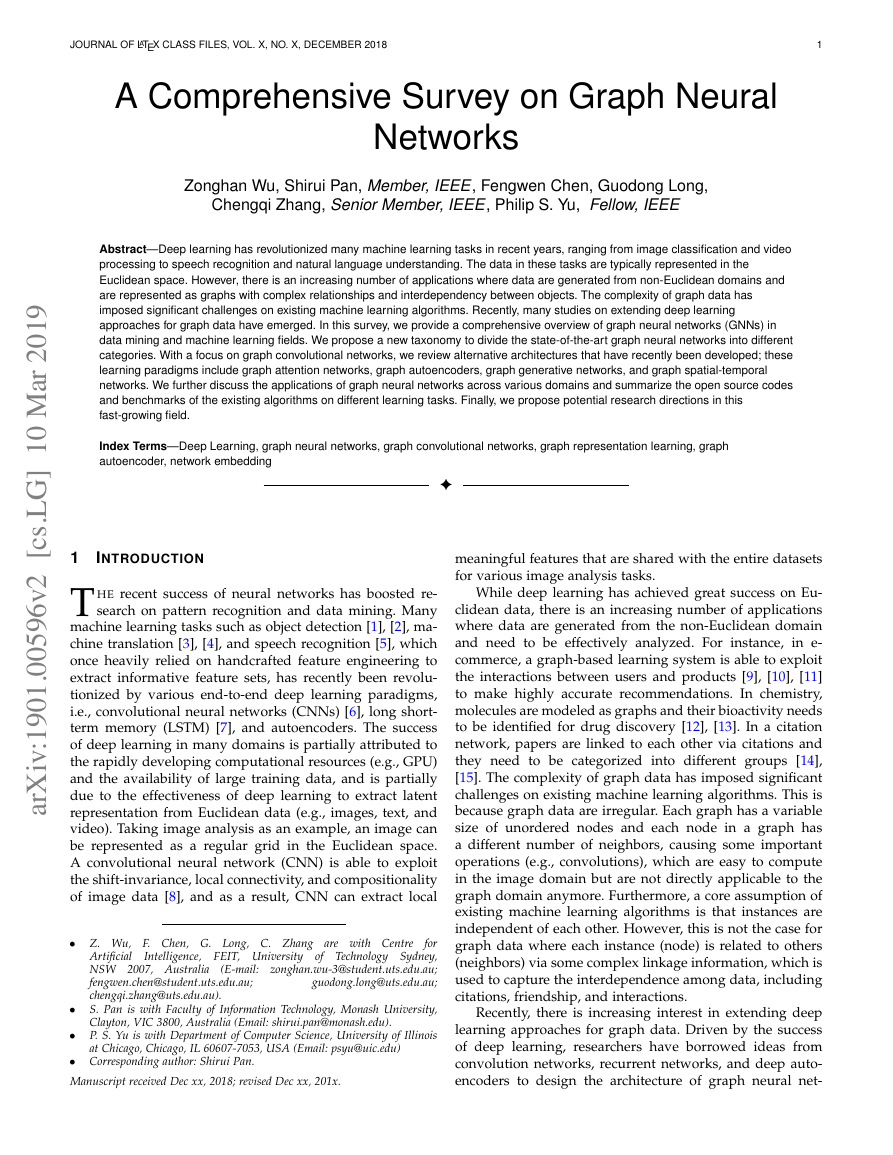

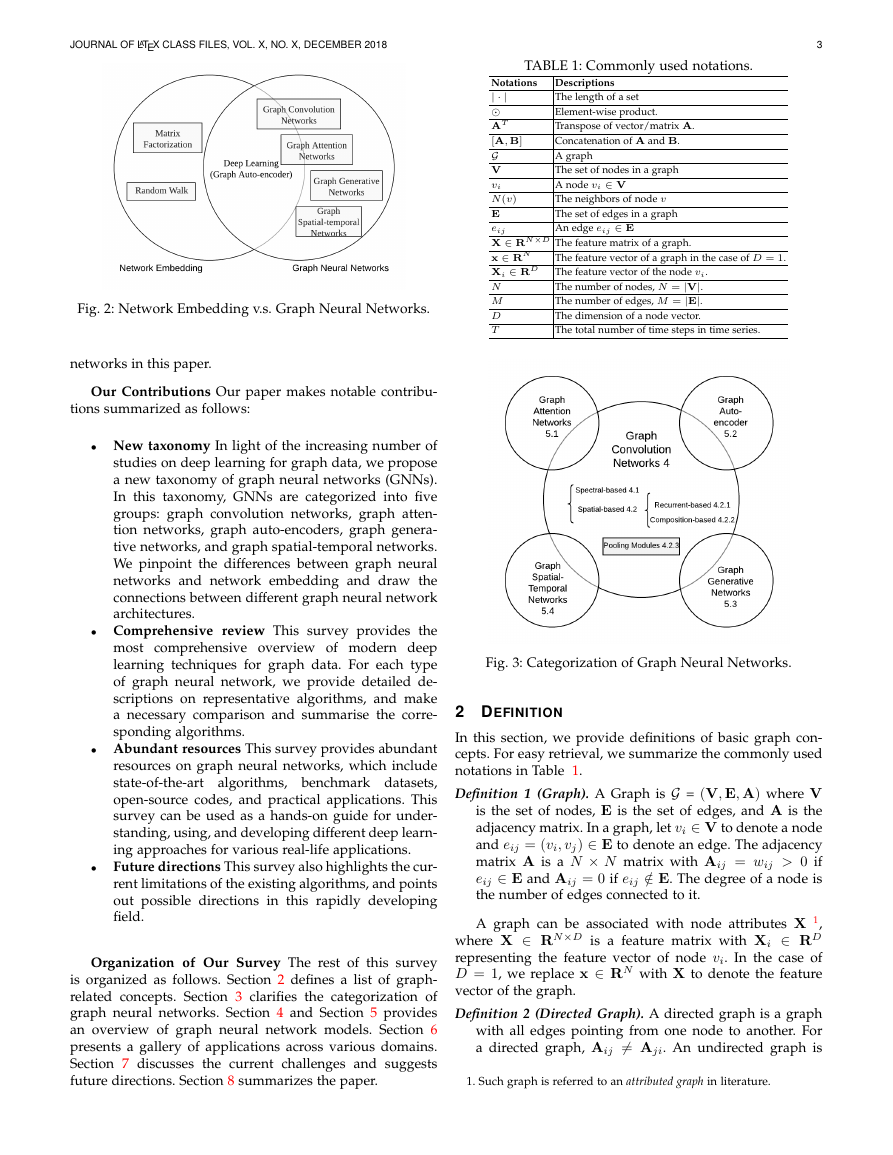
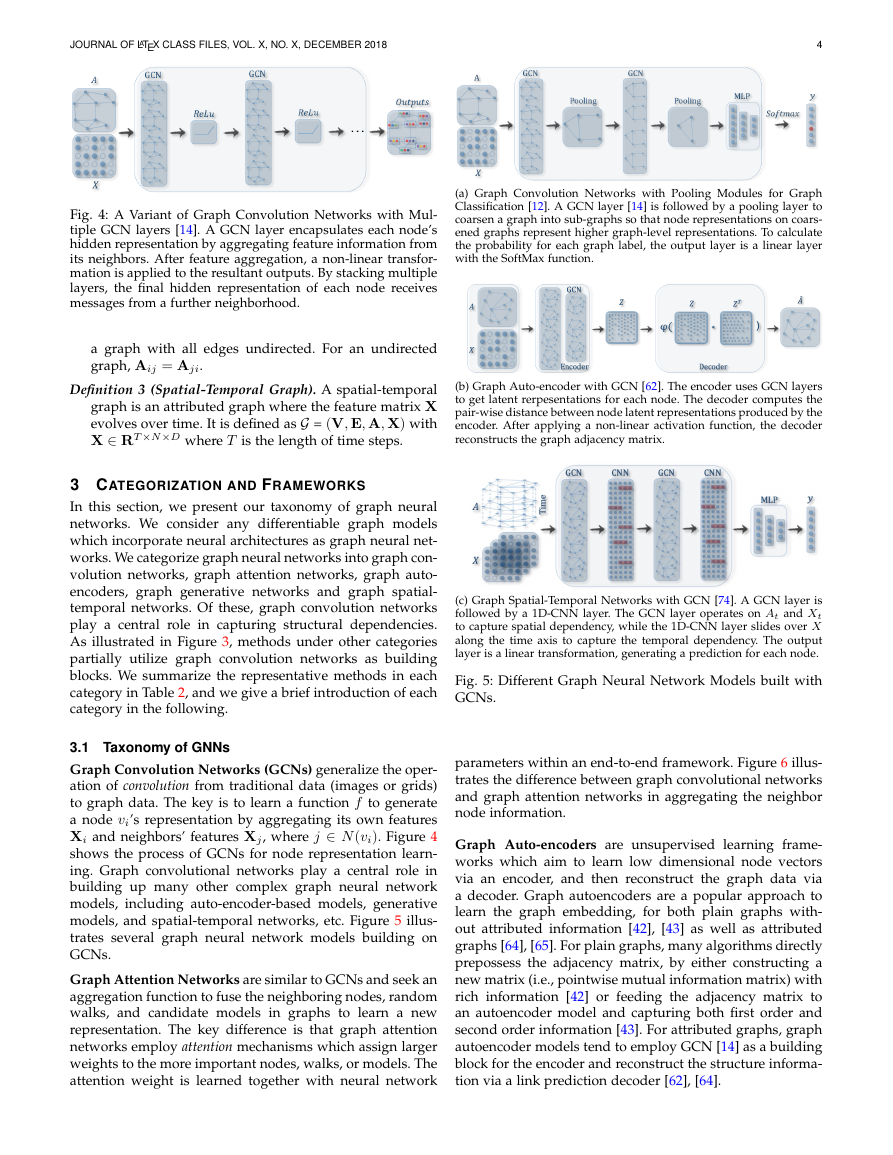
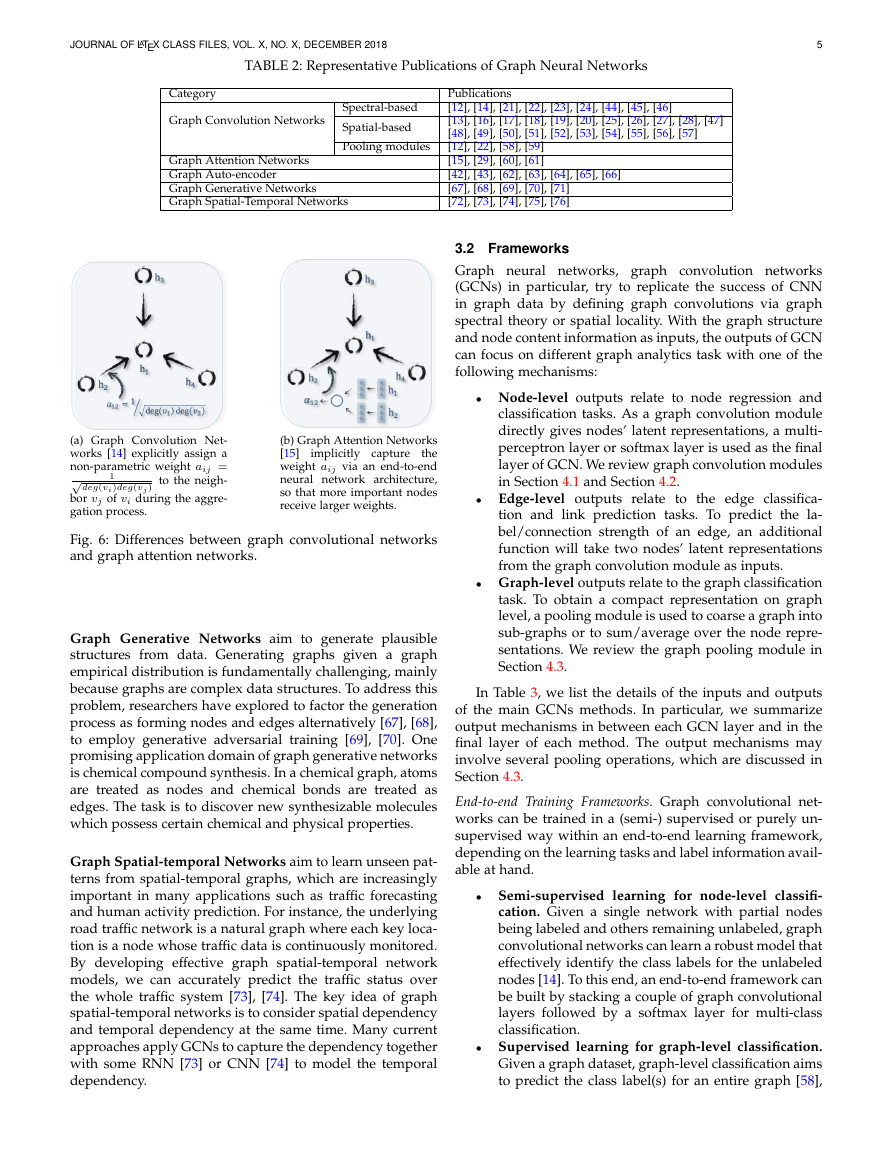
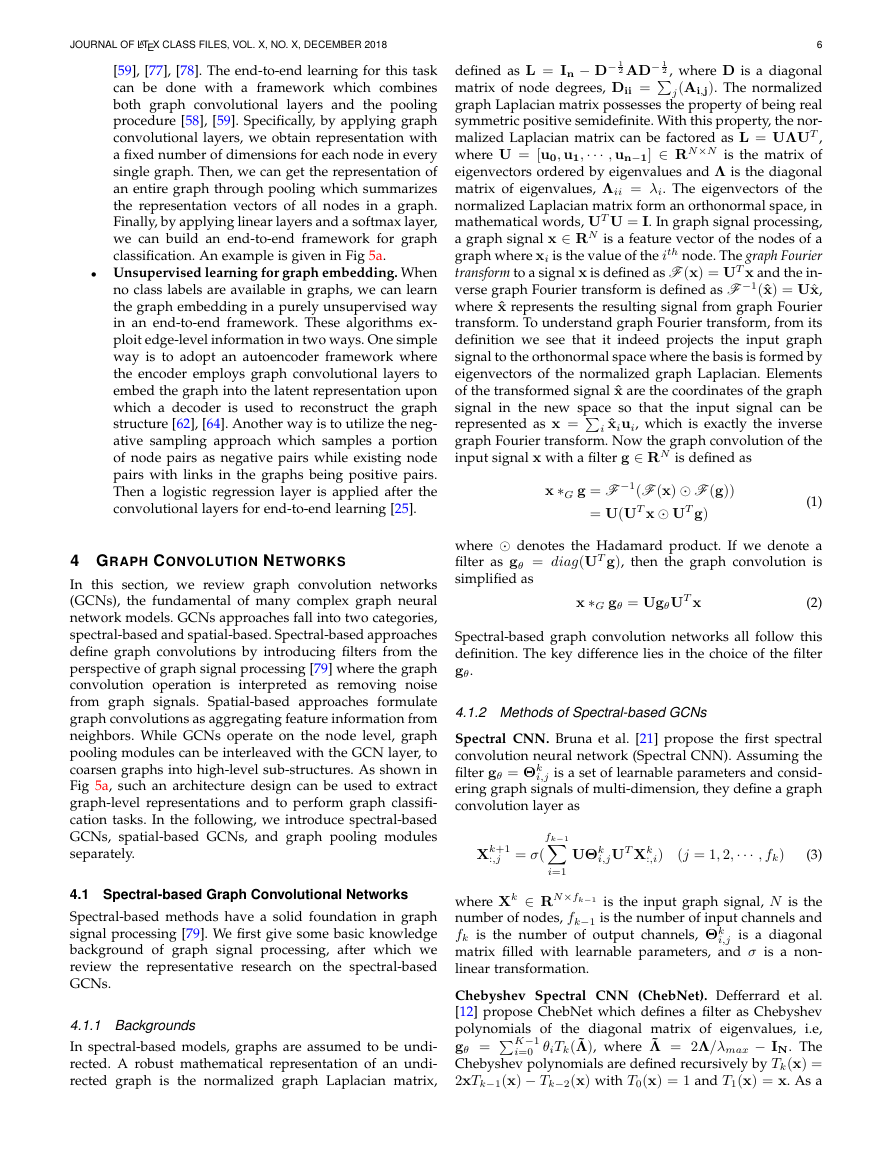
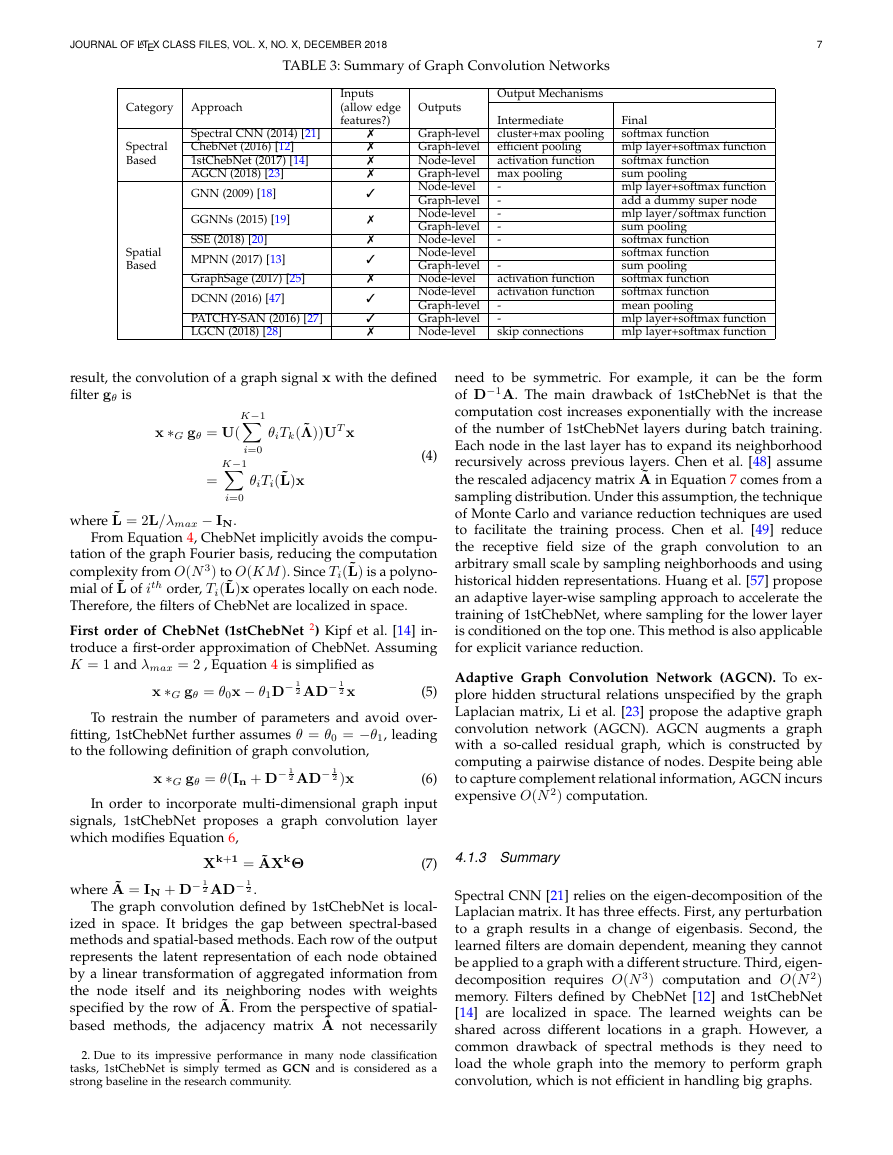
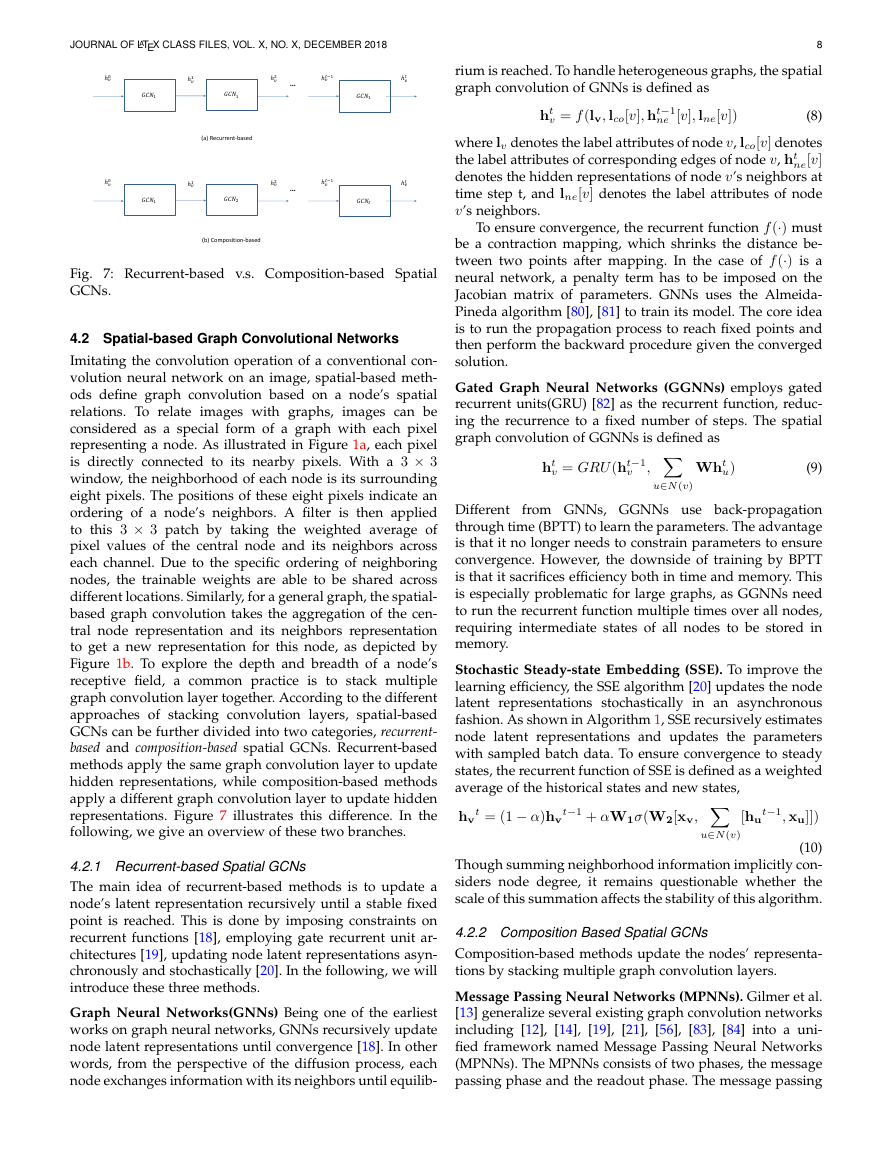








 2023年江西萍乡中考道德与法治真题及答案.doc
2023年江西萍乡中考道德与法治真题及答案.doc 2012年重庆南川中考生物真题及答案.doc
2012年重庆南川中考生物真题及答案.doc 2013年江西师范大学地理学综合及文艺理论基础考研真题.doc
2013年江西师范大学地理学综合及文艺理论基础考研真题.doc 2020年四川甘孜小升初语文真题及答案I卷.doc
2020年四川甘孜小升初语文真题及答案I卷.doc 2020年注册岩土工程师专业基础考试真题及答案.doc
2020年注册岩土工程师专业基础考试真题及答案.doc 2023-2024学年福建省厦门市九年级上学期数学月考试题及答案.doc
2023-2024学年福建省厦门市九年级上学期数学月考试题及答案.doc 2021-2022学年辽宁省沈阳市大东区九年级上学期语文期末试题及答案.doc
2021-2022学年辽宁省沈阳市大东区九年级上学期语文期末试题及答案.doc 2022-2023学年北京东城区初三第一学期物理期末试卷及答案.doc
2022-2023学年北京东城区初三第一学期物理期末试卷及答案.doc 2018上半年江西教师资格初中地理学科知识与教学能力真题及答案.doc
2018上半年江西教师资格初中地理学科知识与教学能力真题及答案.doc 2012年河北国家公务员申论考试真题及答案-省级.doc
2012年河北国家公务员申论考试真题及答案-省级.doc 2020-2021学年江苏省扬州市江都区邵樊片九年级上学期数学第一次质量检测试题及答案.doc
2020-2021学年江苏省扬州市江都区邵樊片九年级上学期数学第一次质量检测试题及答案.doc 2022下半年黑龙江教师资格证中学综合素质真题及答案.doc
2022下半年黑龙江教师资格证中学综合素质真题及答案.doc